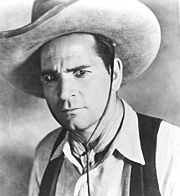November 29, 1896 – May 24, 1986

Movie Cowboy/Stuntman: Yakima Canutt was a popular Hollywood actor and stuntman from the 1920s through the 1950s. He was born Enos Edward Canutt on November 29, 1896 near Colfax, Washington.
As a young man, he was a successful rodeo rider who got the nickname of “Yakima” when he was caught fraternizing with several rival rodeo performers from Yakima, Washington. He met actor Tom Mix at a rodeo in Los Angeles and was persuaded to work as a cowboy in films.
Canutt gained minor success in the 1930s playing mostly villains in a number of B-westerns and serials. But it was his talent for handling horses and taking falls that gained him work, both as a stuntman and stunt coordinator. During this time he worked with a young John Wayne. Since Canutt was an accomplished horseman and a real cowboy, Wayne often sought his advice. Canutt ended up teaching Wayne the finer points of handling horses and about how real cowboys acted.
Yakima Canutt and John Wayne starred in a series of popular B-westerns known as the ‘Lone Star’ westerns. These formula westerns were full of action and were quite entertaining to watch. Canutt had, of course, coordinated and performed most of the hair-raising stunts that made these films so exciting. He is credited with coming up with a method of throwing a screen punch that is standard practice among stunt people today. He positioned the action so that when a punch was thrown, it was always done so towards the camera which would be filming over the shoulder of the receiving actor. When shot from this point of view and with even moderately-accurate timing from the performers, audiences saw what appeared to be a real fight. The realism of all movie fights was increased dramatically as a result of this innovation. Some of Canutt’s top notch stunts include riding a horse off a cliff into a watery chasm, jumping off horseback onto a runaway wagon; running mounts were classic and he could jump straight from the ground into the saddle with just a step or two.
He appeared in the 1939 John Wayne western classic “Stagecoach” and helped Wayne deal with an antagonistic director named John Ford. It was also in this film that Canutt performed one of his most famous stunts: the daring pass under the moving stagecoach. That same year, Canutt could be seen performing stunts in “Gone With The Wind”, doubling as Clark Gable driving the wagon through the burning streets of Atlanta. He also appears as a regular actor in the film as the renegade soldier who attacks Vivien Leigh.
As a stunt coordinator, Canutt staged the famous chariot race segment in the 1959 film Ben-Hur. You can also catch a glimpse of him in the distant shot in which Ben-Hur’s chariot bounces over the wreckage of another chariot, just before the cut to the close-up of Charlton Heston.
Over the course of his career, Canutt developed several devices and special rigging that made stunt work safer for stunt performers while at the same time, making the stunts themselves appear more spectacular. Not a single performer was seriously injured on any of Canutt’s films and many of his safety procedures are standard practice among stuntmen today.
Canutt was given an Honorary Academy Award in 1966 for his achievements as a stuntman and for his development of stunt safety devices. He also has a star on the Hollywood Walk of Fame in recognition to his contribution to the motion picture industry. In 1975, he was inducted into the National Cowboy & Western Heritage Museum (Hall of Fame).
In 1985, Canutt appeared in a music/bio called “Yak’s Last Ride” directed by John Crawford. His sons Joe Canutt and Tap Canutt also worked as stuntmen. His autobiography, “Stuntman”, was published in 1979.





